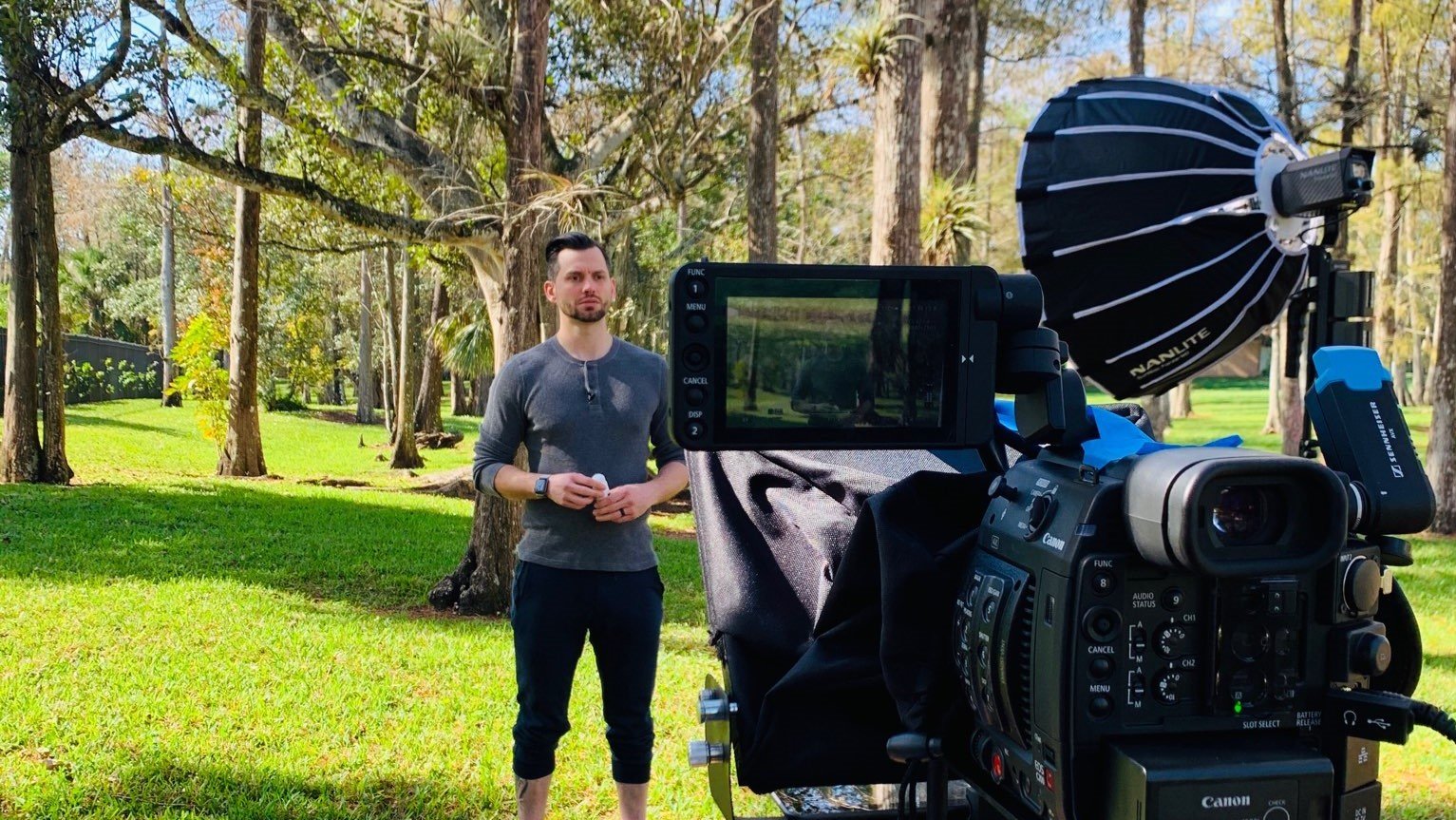Why Video Marketing Works
Videos produce results. Because why else are we doing this?
We live in a digital era, and in the world of digital marketing: Video is king.
Don’t believe us? Well, the marketing world isn’t just heading toward video immersion, it’s there. Already, 87 percent of marketers are using video to reach their desired audience. It’s what consumers want. In fact, 54 percent of consumers say they want to see more video content when they’re online.
So, the question is: How can your company meet these audience expectations? By developing a video marketing strategy.
Videos produce results. Because why else are we doing this?
Let’s get right out with it. A video marketing strategy can help you boost your company’s sales. Well-constructed video has been proven to get better engagement on social media, convert more leads and distinguish a brand’s voice amongst all the visual clutter consumers sift through daily online.
Perhaps less obviously, but just as importantly, videos can help increase the success of your company’s flywheel. That’s right, we said flywheel, not a sales funnel. Cue the gasps.
You may have heard of and even use the sales funnel model to generate new business. In this linear equation, potential customers travel one way through the buyer’s journey and sale process before eventually purchasing your product or service and exiting the funnel.
However, many companies are shifting their sales and marketing approach over to Hubspot’s flywheel model. In this model, the purpose of your marketing is to attract, engage and delight your customers at every stage of the buyer’s journey and customer experience to create momentum that drives business growth. Video can be utilized to serve a purpose in every stage of this model. What makes us say that?

Essentially, good video humanizes your company in a digital world. It allows you to demonstrate your company’s people and values on a more personal level, bringing comfort and delight to customers and leads. This is important because people no longer trust businesses the way they have in the past. According to research, 65 percent of consumers don’t trust company press releases or advertisements. In fact, most people prefer the advice of friends and family over that of businesses. With the right video campaigns, you can boost your credibility almost instantly.
Without an engaging avenue to tell your brand’s story and purpose, there is nothing to set your company apart from the competition. On the other hand, the proper messaging in your content marketing can help small businesses transition to larger ones and even increase the amount of franchise sales in large businesses. We happen to work with a lot of franchises or decentralized business models. You can read more about video’s impact on franchising here.
Step #1: Know who to call.
Of course, understanding that your company needs good video is far easier than actually creating that video, isn’t it? Thankfully, there’s one huge thing you can do to make the process easier: Hire a video production company.
We know, we know. You likely already have a marketing team on staff. But video production is a time consuming process that requires specialized equipment and knowledge of specific and we guarantee your marketing team will welcome the help in creating stellar video campaigns. If you want to really support your video endeavors, you may want to find a digital marketing agency that also produces video.

For instance, in our agency we work collaboratively with our clients to identify what message they would like to get across. We conceptualize video content, write the script, film, edit and even analyze video success. By integrating with your team as partners, we’re able to handcraft a video marketing strategy that’ll make you the envy of the digital world.
It's all about the context.
The easy answer to where you can use video within your company is: Anywhere. But realistically there are key areas that your company should be using video for. The first is on your website.
In the age of the Internet, your website doesn’t just represent your business − it IS your business. For that reason, every company should have these five kinds of video on its website:
The next area you’ll want to make sure you’re using video is on social media. Fun fact: Videos get more engagement on platforms like Facebook and Instagram. Specifically, you want to make sure that any ads that you’re running are using video to promote brand recognition and garner more leads.
Finally, videos can be a great tool for up-selling or cross-selling, particularly when it comes to email. Placing a video in your email blasts can lead to more visits to your website. Did you know that?
Now, we're ready to get cooking.
We’ve talked a lot of conceptual talk so far − creatives have a nasty habit of that −, but thankfully we have the practical skills to back it up. So, what would your company need in order to develop a video marketing plan?
To put it simply:
Short list, big items. Here’s a little breakdown of what each of these means:
First, you’ll want to identify what you’re using your videos for. Are you trying to raise brand awareness? Generate leads? Educate customers about how to solve certain problems?
For example, one of our clients uses video to educate their audience on all things car insurance. This helps their customers make informed decisions about their purchases and builds a reputation for the company as experts in the industry creating that hard-to-come-by trust between the brand and consumer.
You’ll likely find that the purpose of your videos will vary. But to start, you’ll need to identify a need in your marketing strategy and use that as the foundation for your videos.
You can always expand your video production to serve other purposes later.
After you identify what you’re creating videos for, you’ll need to figure out how you’re going to share them with your audience. We offer tips on how to tailor your content to Youtube, social media, emails and more. But you’ll likely end up sharing a large portion of your videos through a video hosting service.
Don’t worry, video hosting is exactly what it sounds like. Services like Vimeo, Brightcove, and Wistia can all be used to host your videos, share them on different platforms and embed them on websites. Of course, there are many hosting services, but those are a few of our favorites.
Choosing the right video hosting platform will be based on your company’s budget and needs. For instance, Vimeo is great for organizing content and sharing via links. However, it doesn’t have the same customization options that Wistia would offer. Identifying and understanding the distribution strategy you want to use will also help you choose a hosting service that will best fill your marketing needs.
Once you’ve got your game plan for how and why you’re sharing these videos. You can get down to the nitty-gritty: Video production. We do have an ultimate guide to video production. However, to cover the basics, you’ll need to do a few things in order to make a video: write a script, gather the right materials and plan out the logistics.
Your script will be the roadmap to your video. That’s your place to play with ideas on how you can deliver your message. Script writing can take hours and requires at least some understanding of the visual layout of video. For that reason, we typically pitch scripts to clients for the marketing team to approve.
Once you finalize your script you’ll be able to get moving on gathering the right materials. If you’re going to be shooting your own footage, you’ll need to have the proper camera and audio equipment. If you’re not, do you have access to stock footage that you can use? What about music?
There are also logistics that will need to be taken into consideration for each video.
How much time will it take? Where will you film and will you need a permit to film there? Will you need any prompts? Voiceovers? Actors? Who will edit the video? Another benefit to outsourcing video production is that most of the answers to these questions are then: "They will handle it".
Once you figure out the logistics, you can begin filming and editing your video.
What went right and what can go better.
Like all marketing strategies, the success of digital marketing and therefore, of your videos is measured after a campaign.
Remember when we talked about using different hosting services and sharing on different platforms? It’s important to understand that different tools will be able to provide you with different analytics. For example, Wistia will provide more detailed analytics in regards to your video than say, Instagram or a web publisher like WordPress.
Your goal or purpose for your video may impact what metrics you look at. However, in general, here some standard statistics that we like to watch out for, including:
Understanding how to track your video marketing metrics is important because it can help you get the best ROI by understanding where your videos perform best. Your video metrics can be used to indicate what type of content your audience likes to engage with. Then, your future videos can be tailored to perform better every time.
At Trifactor, we merge creative design, digital and video to bring you the best results.

Trifactor is a digital marketing agency that’s known for creating awesome videos. That’s what makes us different. Our mission is to help companies grow by merging creative design, digital, and video.
(954) 533-1690
5211 NW 33rd Avenue
Fort Lauderdale, FL 33309
©2024 Trifactor. All rights reserved.